
BlueHost basically have something for you no matter what hosting tier you might be looking for. There are shared hosting plans, WordPress-optimized plans (for WooCommerce stores), as well as VPS servers and dedicated machines.
[toc]
Bluehost Web Hosting Review
Today we’ll be reviewing Bluehost, a titan of the hosting industry and arguably the most popular shared hosting company on the planet. While size and popularity are impressive, they don’t always correlate with the highest quality. Bluehost is one of the oldest hosting companies around and offers a very budget friendly hosting option for both new and seasoned website owners.
The purpose of this article is to bring Bluehost under the microscope to help you determine if it is a good fit for your ecommerce store. To begin, we will share Bluehost’s origin story, highlight pros and cons of the hosting packages offered, and end with a price comparison so you can make an informed decision.

How Bluehost Was Born
Bluehost was founded in 2003 by Matt Heaton, a tech entrepreneur and software developer. Oddly enough he stumbled upon the industry by co-locating with a company called freeservers.com who provided a completely free hosting service. After seeing the tremendous potential in providing a hosting service, Matt started his own free hosting service company.
Matt offered 50 MB of disk space with his free hosting service, which was considerably more than its competition and aptly named his company 50megs.com. Not long after starting his company, About.com acquired Freeservers.com.
Even with this acquisition, Matt’s company 50megs was starting to really ramp up and even began taking customers from freeservers. This caught the attention of About.com who quickly bought up 50megs as well. Matt then found himself doing something he wasn’t particularly fond of, working for someone else in corporate America.
Matt took a couple of years off before jumping back into business with his second hosting venture, 0catch.com which ended up with over 3 million signups and to this date still has over 1.1 million active users. With the help of the 0catch team he had built, Matt set his sights on a more feature rich premier hosting solution – one that still catered to beginner users but also to a more tech savvy user who would pay more for add-on services and enhancements to the core hosting solution.
In July 2003, Matt and his team purchase bluehost.com, chose the infamous cPanel as their control panel, and custom coded the billing system, affiliate system, and signup system from scratch. This custom coding separated them from their competition because they were able to automate many procedures which left them more time to focus on sales and optimization.
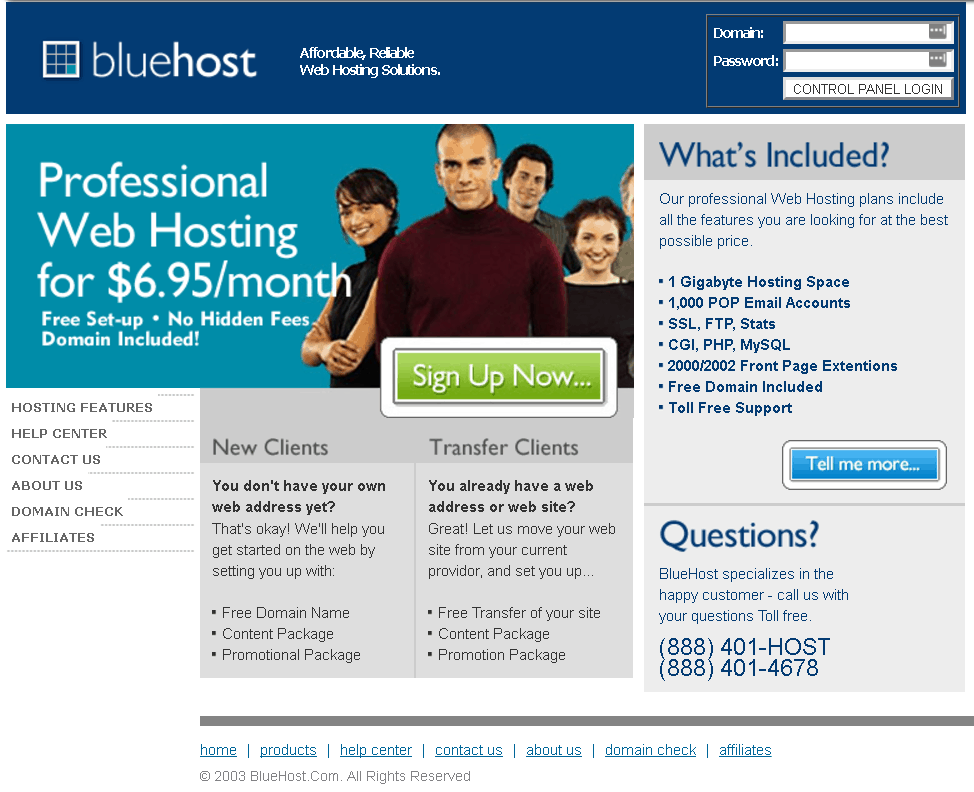
A snapshot of the original Bluehost homepage from December 2003.
The first month Bluehost was live they had fifty-five sign ups. Flash forward to the present day and you’ll find that over two million sites worldwide are hosted by Bluehost. Obviously, the company is doing something right, and in this article, we will break down exactly what Bluehost is doing to attract such a large and loyal client list.
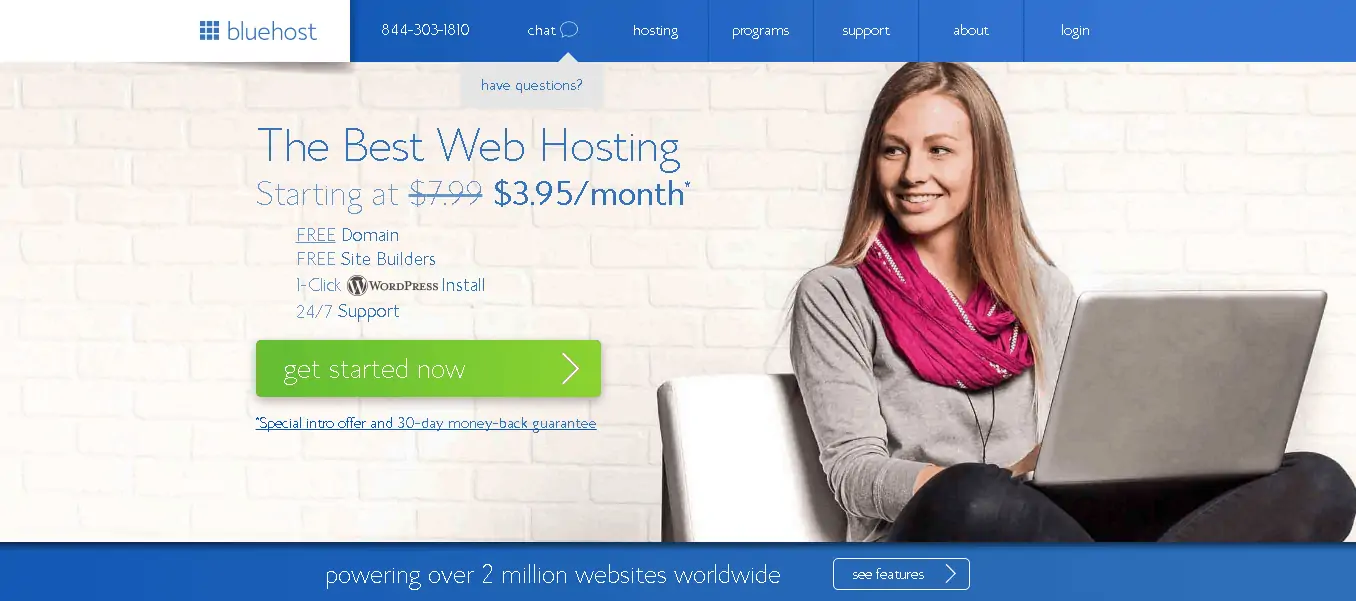
A snapshot of the Bluehost homepage from August 2017
1. Cloudflare Integration
Bluehost has superior content caching system through their integration with Cloudflare. Cloudflare is a company that provides a Content Delivery Network (CDN) which you can think of as an intelligent network that is out in front of your hosting provider’s servers and gives you features like:
- Load Balancing which reduces latency or lagging by balancing load traffic across a multitude of servers or by routing your site’s traffic to the closest server to your customer.
- Added Firewall Protection to automatically detect and protect your site from common vulnerabilities like cross-site forgery, cross-site scripting, and SQL injection attacks.
- Advanced Caching Systems which keeps a copy of your site’s resources on Cloudflare’s data centers which will increase your site’s loading speed and save your original server bandwidth.
- Improved Uptime because even if Bluehost’s servers are down, Cloudflare has a copy of your site cached on their servers and can continue to offer your content to your site visitors.
All these things you used to require added hardware and many more server locations. Now with a Cloudflare partnership, Bluehost can give you all those things without expanding their current network of data centers.

Map of Cloudflare’s global network of data centers.
Rather than having a few or even a dozen server locations to provide your site’s content faster to your customer they can tap into one of over a hundred data centers in Cloudflare’s arsenal. This is how Bluehost can offer a superior hosting product while still keeping their prices competitive.
Bluehost doesn’t come standard with the Cloudflare integration turned on. You do have to enable it. Luckily, doing so is very simple. To start:
- Navigate to your cPanel and click on the Cloudflare icon under the domains section
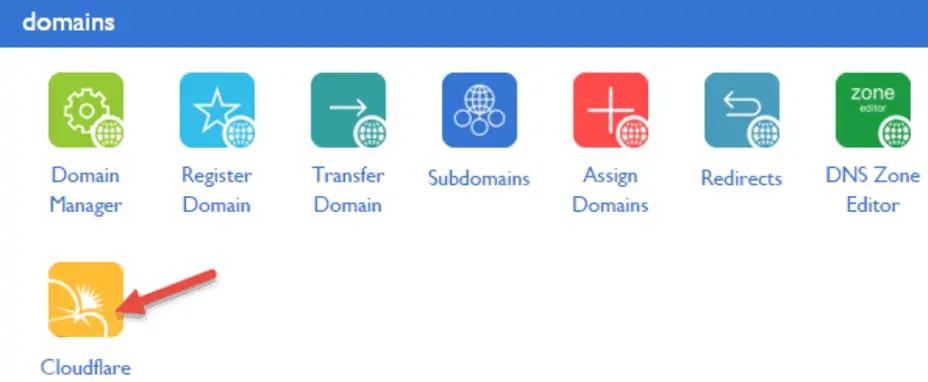
Screenshot of the Bluehost cPanel where you can enable Cloudflare the integration.
- Click Next in the following screen and follow the prompts to create your free Cloudflare account
- Click Activate to enable Cloudflare

That’s it! You are now up and running with Cloudflare. If you have any issues, you can always contact Bluehost Support or read through Cloudflare’s Knowledge Base.
2. WordPress Friendly

Bluehost has been a long-term partner of WordPress and is actually listed on their WordPress recommended hosting page. This partnership has drawn a huge number of WordPress users to Bluehost and has helped shape the training and baseline expertise of each of Bluehost’s support members to accommodate WordPress related optimization and troubleshooting.
An added bonus is that with Bluehost you can get a WordPress site up and running in about 5 minutes. This, of course, is possible because setting up an account, acquiring a domain, and installing WordPress can all be done from the Bluehost site. Bluehost streamlines the process for getting up and running with your WordPress site by providing a 1-click installation.
Once your account is created with Bluehost, you can head over to your cPanel and click on Install WordPress under the website section.

Screenshot of the Bluehost cPanel where you can install WordPress.
Immediately after the WordPress installation is complete, you will be able to login to the backend of your website at yourwebsite.com/admin and start customizing your theme, downloading plugins, and more.
3. Uptime
Bluehost will have some slight variance in performance and uptime, but overall they have a solid 99.97% average which for the price is actually a great deal.
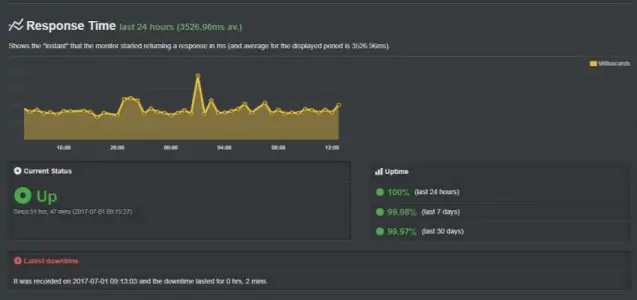
Uptime screenshot of a website hosted on Bluehost’s servers
Furthermore, Bluehost reflects their commitment to offering uninterrupted servers by stating in their Server Uptime Agreement that if you terminate your contract with them early due to server downtime, you will not be charged.
4. Superior Usability and Customer Support

Bluehost uses the world standard cPanel which provides easy to manage website tools that novice users and advanced users alike. This makes tasks that seem complicated like creating subdomains or transferring domains incredibly user-friendly. Finally, the most notable advantage of using the cPanel is the sheer volume of users worldwide. With millions of users, it is very easy to find solutions to problems, tutorials, and advice from other users to get the most out of your website.

5. Customer Service
Bluehost’s support team is an area that gets mixed reviews. Many of their clients report positive experiences with service agents who were friendly, helpful, and quick to action. Unfortunately, you will also find a fair number of customers who were unable to get the help they needed even after several phone calls. With that in mind here are some of the pros and cons of Bluehost’s support:
Pros
- They have a Live Chat button on every page of their website which makes it easy to get help when you need it no matter where you are on the site. This feature has quickly replaced their email support option and has become a 24/7 option so you can get help around the clock.
- Their close partnership with WordPress gives you access to WordPress experts who will know how to troubleshoot issues related to WordPress and know how to optimize your WordPress site for peak performance.
Cons
- Excessive upselling has been reported and can be frustrating because many add-ons are essential for full functionality. All these add-ons can really add up if you are on a tight budget.
- While they have 24/7 support you really only get that option for technical support. If you have billing or administrative inquiries, you will have to contact them during regular business hours.
In the end, you will likely find Bluehost’s support staff to be capable, and you’ll likely have an average or at least adequate experience.
6. Optimized for Ecommerce

Bluehost for ecommerce is a smart move, especially if you are on a tight budget or plan on using WordPress and/or WooCommerce for your store. Not only are they the recommended hosting provider for WordPress but also for WooCommerce. BlueHost lets you start selling on your online store within minutes as the WooCommerce application is simple and easy to install.
In addition to ease of use you also get added benefits like a free domain for a year and a Free SSL security with every account that has a dedicated IP address (exclusive to the Pro Plan). If you have a WordPress site hosted through Bluehost you get a shared SSL certificate which you can turn on in the cPanel. At $6.95 a month, it is hard to beat Bluehost’s hosting package for your WooCommerce powered WordPress store.

August 2017 screenshot of Bluehost’s WooCommerce + WordPress hosting package
Last but not least, you get a promotional offer of $100 – $300 in Google advertising credits with each new Bluehost account. Meaning you can start driving traffic and hopefully getting some sales in a matter of hours with your new store.
With Pros Must Come Cons
1. Bluehost does not offer month-to-month shared hosting options.
When purchasing any hosting plan with Bluehost, you automatically agree and pay for at least a 12-month plan up front. You have the added options of a 24 or 36-month plan but Bluehost does not offer a monthly plan. For startups and starter sites this large upfront cost can really stretch an already tight budget and might turn away some potential customers. If however, you are committed to being in business at least a year then you will still find that Bluehost has one of the best hosting deals around.
2. They charge a large fee to have your site migrated
Coming from a different hosting company and want to transfer your site? This task could cost you big with Bluehost. While most hosting companies offer this service at no cost, Bluehost charges $149.99 for this feature. They aren’t shy about it either; this graphic (shown below) is directly on their homepage. So while Bluehost may be great for new sites, this hefty fee might deter you when you’re considering your hosting options if you are migrating an existing site.

3. No uptime guarantee
While Bluehost used to offer an impressive 99.9% uptime guarantee, they have recently removed this from their website. Many competitors offer some sort of compensation in the form of a percentage taken off your monthly/yearly bill for certain levels of downtime. Bluehost, on the other hand offers no such compensation and instead offers their Network / Server Uptime Guarantee which allows you to cancel without penalty as stated earlier.
Bluehost Plans And Pricing
Now that you have a baseline understanding of what makes Bluehost tick it is time to break down some of the hosting packages and their corresponding cost. While we have stated above that Bluehost is an extremely affordable option it can vary considerably in what features you get for different pricing tiers. In the section below we will dissect each package so you can determine which might be the best fit for your website.
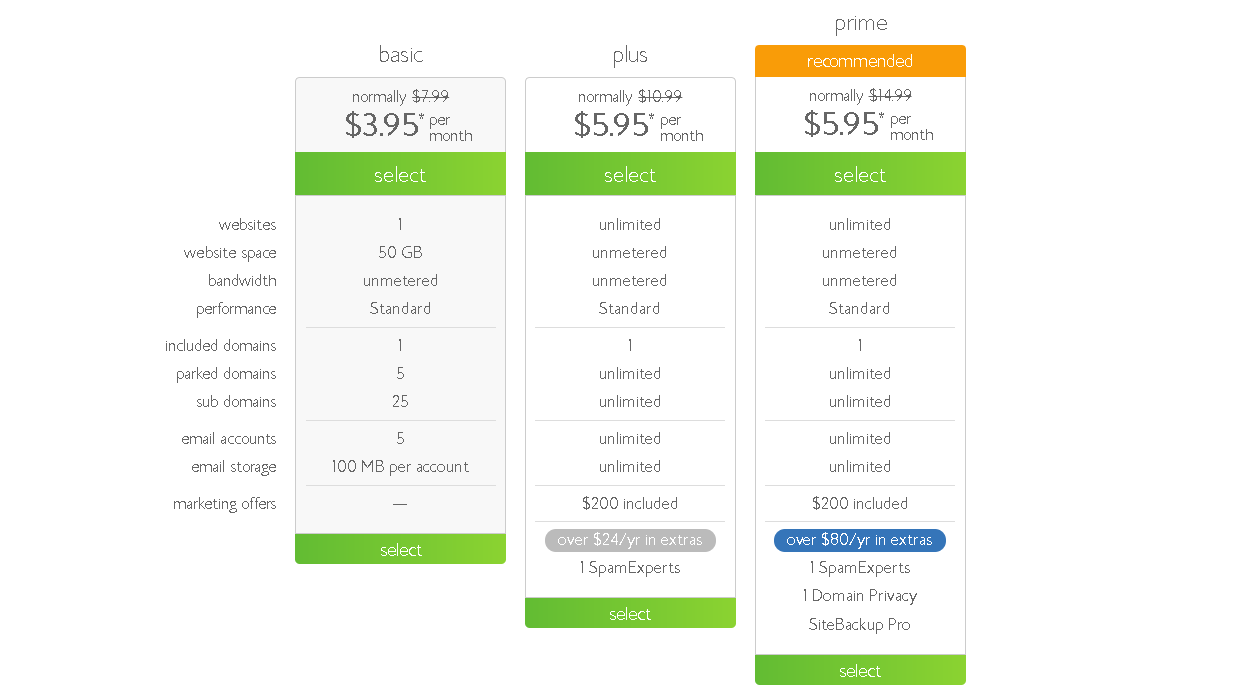
August 2017 Bluehost hosting packages and pricing list
The Basic Plan is one of the cheapest hosting plans around making it the popular choice for beginners and budget conscious shoppers alike. You are limited to hosting one website on the basic plan, but you will still get peak performance, a free domain, and unmetered bandwidth to get your site off on the right foot.
The Plus Plan is ideal for those looking for more space and more flexibility. This plan gives you the option to host unlimited websites, and with it you get unmetered space for your site. This plan is ideal for sites looking to grow fast, developers, and serial entrepreneurs. You still get a free domain, but as an added bonus you get unlimited email accounts, email storage, and subdomains where the basic plan will limit you in those areas.
The Prime Plan gives you everything the plus plan offers but gives you SiteBackup Pro and Domain Privacy. SiteBackup Pro levels up your backup options by allowing you to chose custom intervals for backing up your website and gives you the option to download those backups. Domain Privacy blocks your personal contact information from the whois directory. This keeps your name, address, email, and phone number off of marketing lists which can be used to spam you or plague you with unwanted correspondence from salespeople.

The Pro Plan gives you everything the Prime Plan offers but you get a higher performance server, dedicated IP address, and an SSL certificate. This plan is ideal for high traffic sites and ecommerce sites which benefit more from faster load times and advanced security features. The high-performance server means a better user experience and the SSL certificate gives you a more secure website which will encrypt sensitive information like credit cards from those with malicious intent.
It’s also worth noting that Bluehost offers a generous 30-day money back guarantee with every hosting package so you can try out their services with peace of mind. For the most up to date prices, check out the Bluehost sign-up page.
Bluehost e-commerce hosting review: pricing
As I mentioned above, there’s a couple of interesting hosting plans available with Bluehost. Let’s look into them one by one:
| Shared Plus | Shared Business Pro | VPS Premium | VPS Ultimate | WordPress Business | |
| Hosting Plan Type | shared | shared | VPS | VPS | VPS |
| Disk Space | 150GB | unmetered | 120GB | 240GB | 120GB |
| Bandwidth | unmetered | unmetered | 3TB | 4TB | up to 600 million visits / month |
| RAM | not listed | not listed | 6GB | 8GB | 6GB |
| Dedicated IPs | not available | 1 | 2 | 2 | 1 |
| SSL certificate | not available | included | included | included | included |
| PRICE | $5.95 / month | $13.95 / month | $44.99 / month | $59.99 / month | $60 / month |
| * prices for the first month |
Summary
The hosting industry has really specialized in the last decade, which gives you insanely specific options for you to choose from. While some offer the best customer support, they may lack in other areas like add-ons and uptime. The good news is you can still find top-tier hosting providers who provide a baseline of features and support for your hosting needs. Bluehost fits that description nicely.
Overall, Bluehost is a solid choice for your website or ecommerce store. Bluehost is a veteran hosting company that has figured out how to keep their prices low and competitive while still offering a product that is fast and reliable. If it works for over two millions users worldwide, then chances are it will work well for you.
What’s important to you when it comes to selecting a hosting provider? Tell us in the comments below.
The specific plan you end up selecting is, of course, up to you, but remember that going with the cheapest solution on the list can backfire in the future.
In my opinion, and especially with a business like an e-commerce store, it’s worth to start with a quality VPS plan (or WordPress-optimized plan) that your site can grow with. Those plans offer good scalability and reliability – something that is going to become very important for your e-commerce store once it starts growing.

Comments are closed.